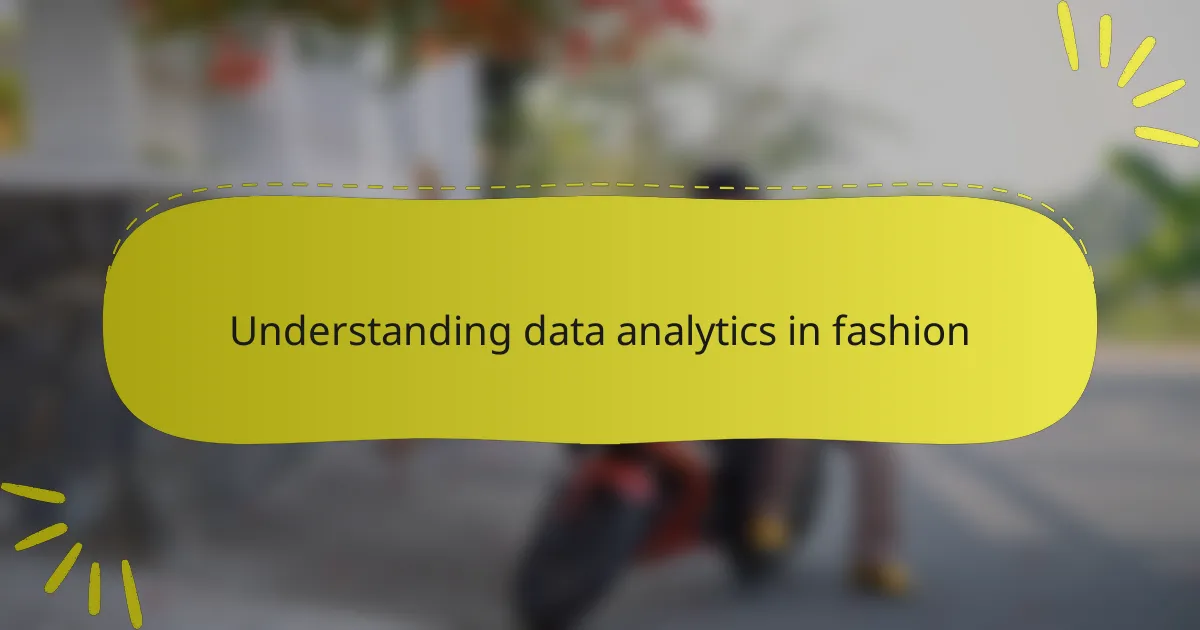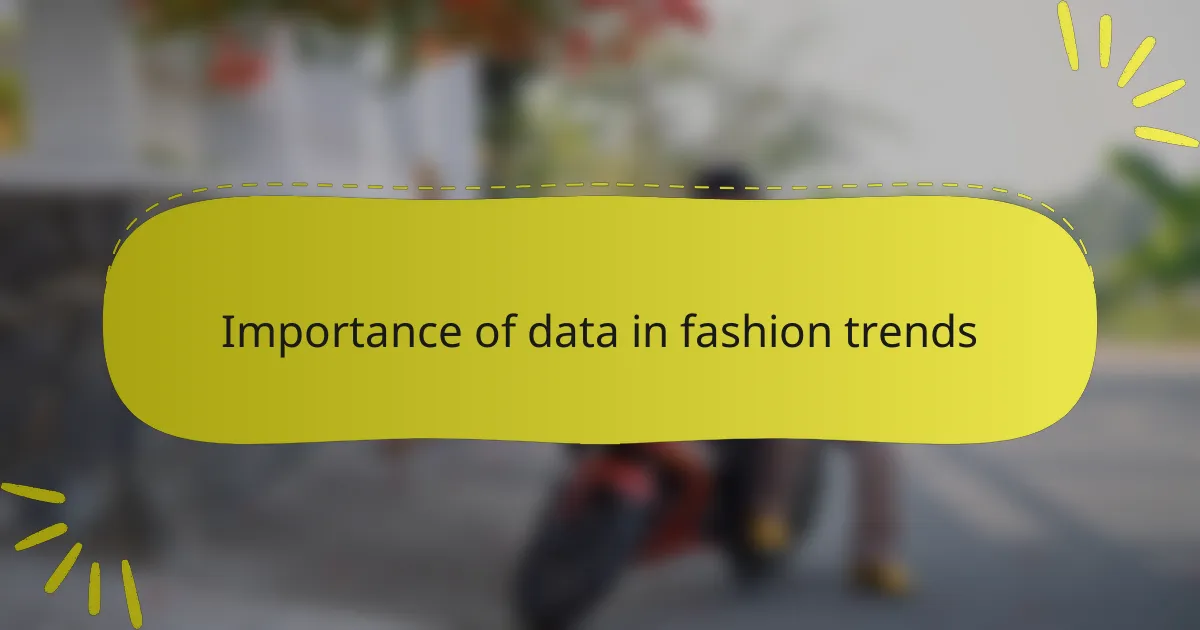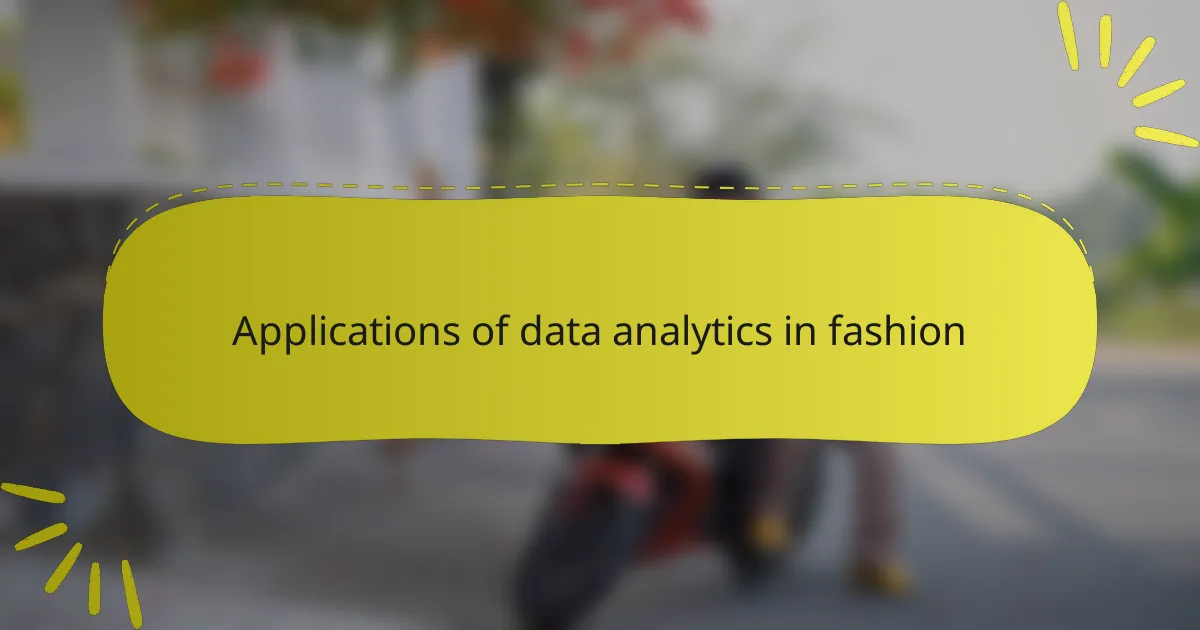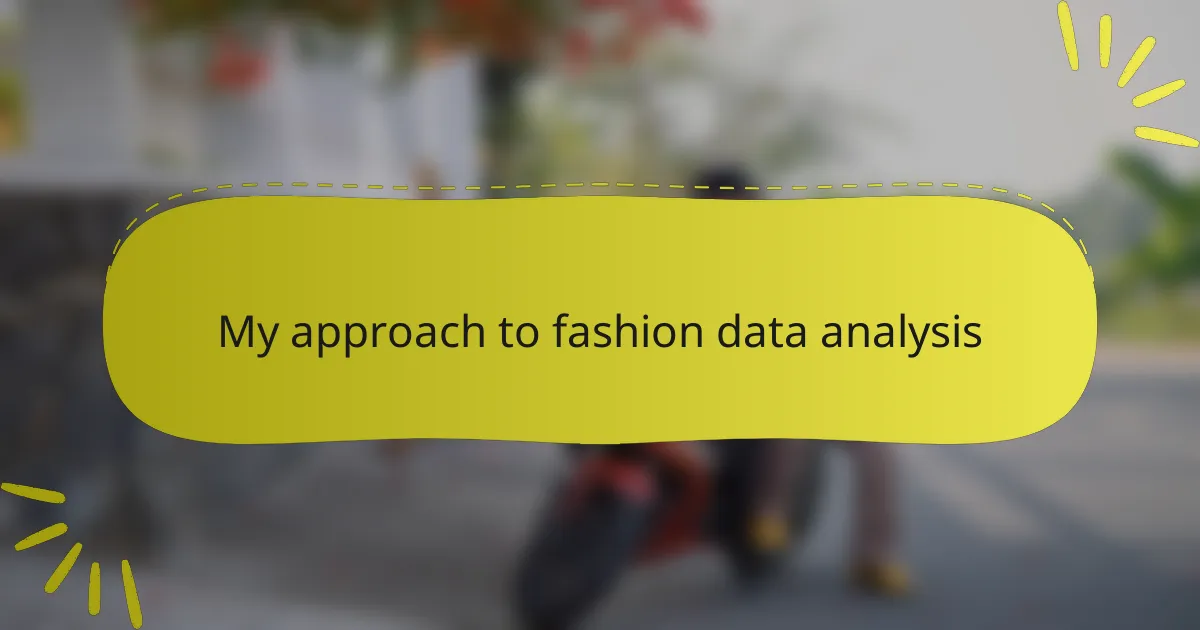Key takeaways
- Data analytics enhances trend identification and consumer insights, allowing brands to create collections that align with current preferences.
- Tools like Google Trends and Adobe Analytics are crucial for tracking consumer behavior and forecasting market shifts.
- Successful examples like Zara and Nike illustrate how real-time data can optimize inventory management and personalize marketing strategies.
- Data-driven decisions foster stronger connections with consumers, increasing engagement and ultimately boosting sales.

Understanding data analytics in fashion
Understanding data analytics in fashion is essential for tapping into the pulse of consumer preferences. From my experience, data analytics helps brands decipher trends that may not be immediately obvious. For instance, analyzing social media interactions can reveal which styles resonate with different demographics. This is invaluable for crafting collections that truly speak to the audience.
I recall a time when a brand I worked with utilized data analytics to reposition its line based on emerging trends. They discovered that specific hues were gaining popularity, which prompted them to pivot their design strategy. The results were remarkable; not only did sales increase, but customers also felt more connected to the brand. It’s incredible how data can transform instinctual decisions into informed strategies.
To give a clearer picture of how data analytics is used in fashion versus traditional approaches, I’ve created a comparison table below:
| Aspect | Data Analytics Approach | Traditional Approach |
|---|---|---|
| Trend Identification | Real-time insights from social media and sales data | Seasonal forecasts and gut feelings |
| Consumer Insight | Detailed segmentation and analysis of buying habits | Generalized target demographics |
| Inventory Management | Data-driven predictions minimize overstock | Static plans often lead to excess inventory |

Importance of data in fashion trends
Understanding the importance of data in fashion trends is something I’ve grown more passionate about over time. Data gives us a clearer picture of consumer preferences and market shifts, which can be the difference between a hit collection and a missed opportunity. For instance, I once observed how rapidly a specific color trended on social media, and by analyzing those patterns, I was able to guide my own design decisions effectively.
Moreover, data offers insights that can significantly enhance decision-making. By leveraging analytics, brands can predict trends before they even surface.
- Identifies emerging consumer preferences.
- Informs design choices and marketing strategies.
- Helps brands forecast inventory needs.
- Enables targeted advertising based on customer behavior.
- Analyzes social media interactions to gauge interest in styles.
Every time I see a brand leverage data effectively, it reinforces my belief in its power to shape the future of fashion.

Tools for analyzing fashion data
When it comes to analyzing fashion data, a variety of tools can significantly enhance our understanding of emerging trends. I’ve personally found that platforms like Adobe Analytics and Google Trends are invaluable. They not only help in tracking consumer behavior but also provide insights into seasonal shifts and popular styles. For me, diving into this data feels like being a fashion detective, uncovering the clues that lead to the next big trend.
In addition to these, there are specialized tools tailored for the fashion industry that streamline the process even further. These can offer deeper insights and allow for a more nuanced approach to data analysis.
Here are some effective tools to consider:
- Google Trends: Perfect for tracking search interest over time.
- Adobe Analytics: Helps analyze consumer behavior effectively.
- WGSN: Offers trend forecasting specifically for fashion.
- Social Listening Tools (like Brandwatch): Monitors conversations and sentiments around brands.
- Looklet: Provides data-driven visual representations for ecommerce.
- PINTEREST Trends: Useful for uncovering visual trends based on user searches.
Using these tools, I’ve seen firsthand how informed decisions can drive creativity and innovation in fashion.

Applications of data analytics in fashion
Data analytics has a myriad of applications in fashion that can redefine how brands operate. One compelling example is using analytics to anticipate consumer purchasing habits. I remember a time when a brand I collaborated with analyzed past buying patterns leading up to a holiday season. By noticing spikes in specific categories, they adjusted their inventory accordingly, which resulted in a notable sales increase. Have you ever faced inventory shortages or overstock? With data, those challenges can be minimized.
Another fascinating application of data analytics is in personalized marketing. I’ve seen how brands leverage consumer data to create tailored advertising campaigns that resonate at a deeper level. This not only fosters a stronger connection with potential buyers but also enhances overall customer satisfaction. For instance, one time, a campaign that highlighted personalized recommendations, based on previous purchases, led to an impressive boost in engagement. Isn’t it amazing how data can speak directly to our preferences?
In addition to these tactics, brands increasingly use data analytics to curate social media strategies that align with trending topics. I’ve witnessed firsthand how monitoring social media conversations allows brands to adjust their messaging on-the-fly. This adaptability can be the difference between being relevant or falling behind the curve. As I recall, a specific brand capitalized on trending music genres to align their new collection launch, and the response was extraordinary. Doesn’t it make you think about how quickly trends can change and the role data plays in staying ahead?

My approach to fashion data analysis
When it comes to fashion data analysis, my approach is both intuitive and analytical. I love the intersection of creativity and numbers; it’s like piecing together a puzzle. For instance, one time I collaborated with a small boutique looking to understand seasonal trends. By analyzing sales data, we identified that certain colors were more popular during specific months, leading to focused marketing campaigns that not only enhanced their inventory strategy but also added a personal touch to their offerings.
In terms of methods, I focus on a few key aspects:
- Sales Data Analysis: Understanding which products are flying off the shelves helps in forecasting future trends.
- Social Media Monitoring: Platforms like Instagram and Pinterest provide real-time insights into what styles are resonating with consumers.
- Customer Feedback: Surveys and reviews can reveal hidden preferences and emerging trends that raw data might miss.
- Seasonal Variations: Analyzing how consumer behavior shifts with the seasons allows brands to stay ahead of the curve.
Through these methods, I’ve seen how data can transform not just the business aspect of fashion, but also the emotional connection consumers have with products.

Case studies of successful data use
When I think about successful data use in fashion, I often reflect on how brands like Zara have revolutionized their approach to inventory and trend forecasting. By analyzing sales data in real time, they’ve managed to turn around collections within weeks instead of months. This agility not only keeps them in sync with consumer demand but also creates a sense of exclusivity, leaving customers eager to purchase new items before they disappear.
Another fascinating case is Nike, which leverages data analytics for personalized marketing. They analyze customer preferences and behaviors to design campaigns that resonate deeply with individual shoppers. I remember when I received a targeted email showcasing new running shoes based on my previous purchases; it felt like they truly understood my needs, making me more inclined to buy.
- Zara: Uses sales data to quickly adapt collections and manage inventory, enhancing customer satisfaction and increasing sales.
- Nike: Analyzes customer data for tailored marketing, resulting in a more personal shopping experience that fosters loyalty.
- ASOS: Employs predictive analytics to forecast trends, enabling them to introduce styles just as they gain popularity.
- H&M: Implements data-driven sustainability initiatives, improving supply chain efficiency while appealing to environmentally-conscious consumers.